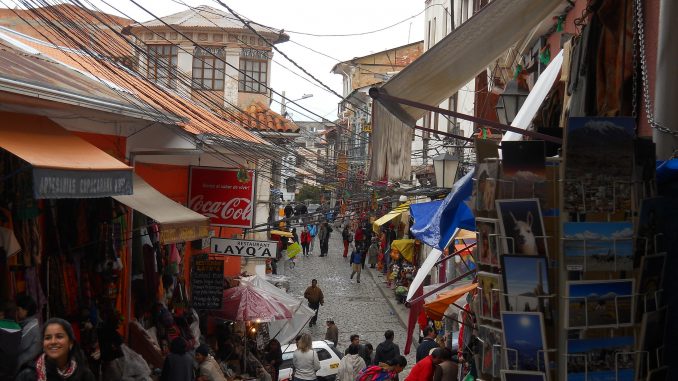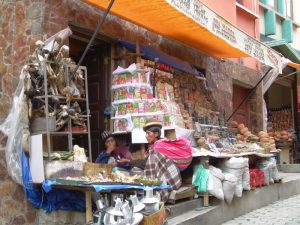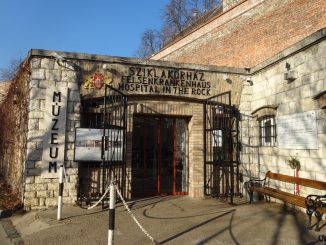
La Paz, Bolivia is a city where the modern and the ancient walk hand in hand. A city where you can unironically hear a jazz pan flute from a shop window and it doesn’t seem remotely odd or out of place.
Along the Calle Jiminez and Linares, just one block from La Basilica de San Francisco in La Paz between Sagarnaga and Santa Cruz, the witches’ market is one of the few places that seamlessly mixes traditional healing, Aymaran beliefs, sight-seeing, and shopping. While it’s a great place to pick up local handmade leather goods like belts and wallets, or colorful Aztec print handbags, and rugs, its name is not some sort of joke or ploy to draw in tourists.
The market does in fact sell a wide variety of herbs, tinctures, candles, and medicines associated with ancient Bolivian folk traditions and it’s run by witches known as yatiri. It’s also the place to go for a variety of potions, spells, feathers, or medicinal plants taken from the Amazonian forests and crushed into powder, as well as a healthy dose of spiritual advice. Occupying a small section of a few blocks in a heavily trafficked part of the city, the witches’ market is still a place where Aymaran beliefs are strongly held onto and ancient healing arts are practiced every day.
Climbing the steep hills in La Paz’s Rosario district will bring you to El Mercado de Hechicheria, the witches’ market, an old cobbled street lined with shops covering two streets in the old quarter of La Paz. The witches’ market has been operating in one form or fashion for centuries, and the medicine women, witches, fortune tellers, and astrologers have long lined the streets waiting to help the wayward. Upon entering the market you’re greeted with rows of vendors, little abuelitas sitting lazily on the stairs of the cobblestone streets, tables piled high with dried herbs, feathers, candles, and soapstone amulets. The altitude mixes with the heavy scent of incense, and the sights of a modern city blend with the traditional.

The yatiri are more witch doctors or healers rather than witches in a western sense, and they wander the market offering fortune-telling services. Identified by their black bowler hats, brightly colored dresses, and coca pouches, the yatiri are practitioners of a form of “witchcraft” that has its roots in ancient Bolivian traditions, and they are some of the last traditional witch doctors in South America. The yatiri don’t make the first move in healing, they patiently wait for someone to come to them with a physical, psychological, or spiritual problem. Their practice predates both Spanish colonialism and the Inca, and they have been selling their services in this region for hundreds of years. Unlike western medicine the yatiri view health as a relationship between a community, nature, and ancestors long passed. They are the community healers rather than those casting spells.
The market has a deeper and more macabre history than the average person sees. With tinctures designed to provide and array of results from stopping a wondering man to bringing wealth to the drinker, the witches market is a place for locals with traditional beliefs as much as it for tourists looking for trinkets. Many of the items sold at the market are used in rituals to bring health, love, intelligence, protection, happiness, wealth, or longevity. They are designed to appease or manipulate the spirits of the Aymara world.
Dried llama fetuses are one of the most prominent and photographed products available at the market. Hanging from open doorways, lying stacked in wicker baskets, or leaning petrified against the walls of the alley, their hollow eyes and open mouths cast a disturbing scene to those not familiar with the traditions. The llamas range in size and are used throughout the country when building new homes. Buried under the foundation of any new construction, a llama is a sacred offering to the goddess Pachamama. It is believed that a llama buried under the foundation keeps the construction workers safe and brings good luck and prosperity to the inhabitants. Wealthy Bolivians go the extra mile and sacrifice living llamas.
Pre-dating the influx of tourists, the witches’ market used to cater exclusively to locals, and behind the scenes it is still very much a market for the locals that also happens to get a fair bit of business from tourism. While the majority of the money is made from the tourists looking for trinkets and photo opportunities, the real work of the yatiri is done in the little smoky shops when the tourists have gone back to their hostels for the evening, or moved on to other parts of South America. While it may seem that the traditions have been watered down for an international pallet, they are in fact much the way they have been for generations. The yatiri are more than shop keepers, and the beliefs they hold are part of the history and traditions of Bolivia.
The women and men that work in the market are not only vendors or shop keepers. They are in fact practitioners of traditional medicine and many of them have been in the family business of healing for generations. They take their work seriously and after the tourists have paid their bills they have the opportunity to work in their communities to make a healthier relationship between the natural environment and the people living in the modern society.
Many of the witches, folk doctors, medicine women, fortunetellers, and astrologers live as well as work on the Calle Linares, so it’s important to be respectful. Remember when adventuring through the witches’ market, that it is a serious and sacred place. While soapstone amulets may not seem filled with spiritual importance to the average tourist, they are sacred symbols to the yatiri, and though many of the yatiri are happy to answer questions and smile for tourists’ cameras, they are not props, and they don’t want their pictures taken without permission.
Navigating the witches’ market is not just a part of visiting La Paz, it’s a fulfilment of powerful spells cast by the yatiri years ago. They were determined to increase business, and believe that the steady increase in tourism is due in part to the sacrifices they have made to Pachamama. Walking through the witches’ market offers the opportunity to look into the soul and history of Bolivia. To see the relationship of people with a spiritual history and the natural environment. If you’re suffering from altitude sickness, looking for safe travels on the rest of your trip, or trying to change your luck for the better, El Mercado de Hechicheria is an absolute must see.


